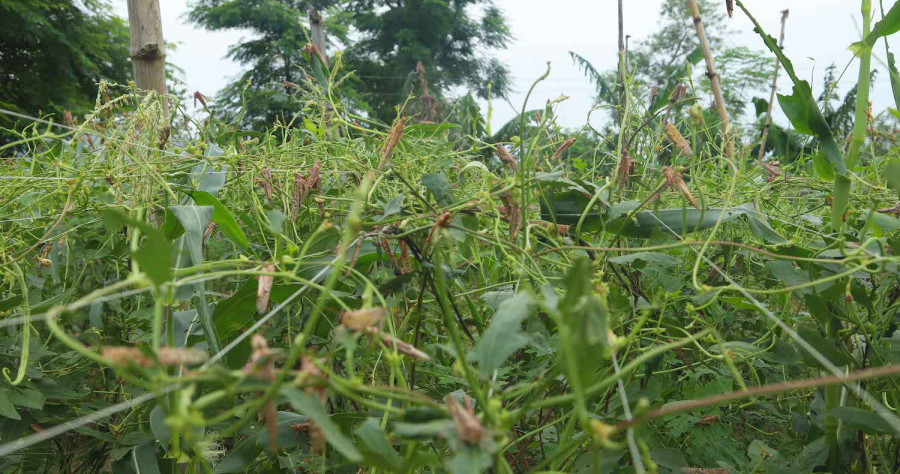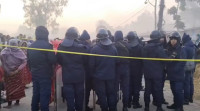National
Eight million locusts have entered Nepal, consuming hundreds of hectares of crops
Changing wind directions are likely to bring in even more locusts in the days to come, officials warn.
Chandan Kumar Mandal
Lal Bahadur Kewat of Lohraula in Buddhabhumi Municipality, Kapilvastu was busy transplanting paddy on Monday when his neighbour informed him that a swarm of locusts had descended on his vegetable farm.
By the time Kewat reached his farm, his green beans and bitter gourds on one-and-a-half katthas of land had already been destroyed.
"Everything was completely ravaged. I just cried looking at the loss," said Kewat. "We [farmers] are being hit from everywhere."
Kewat had taken a loan of Rs20,000 for his vegetables, which had just begun to bear fruit. With green beans and bitter gourds in season, he had hoped to earn Rs150,000.
“It’s all gone,” said Kewat, who has a family of six to feed.
Farmers in Kapilvastu have lost most of their crops to a plague of locusts that arrived from India on Sunday and Monday. According to Daya Shankar Kewat, a farmer in the district, crops worth more than Rs1 million have been destroyed.
Even as farmers are grieving over their losses and officials have yet to estimate the damages done by the migratory locusts, the country is bracing for another locust assault, with more swarms headed to Nepal over the next few days, according to the Agriculture Ministry.
The first swarm of locusts, which had entered the country on Saturday morning, have already wrought havoc on a number of districts, especially in the Tarai. Since then, the locusts have quickly spread to 27 districts, including districts as high as Khotang, Okhaldhunga, Rukum West, Mustang and Solukhumbu.
These large swarms are regularly breaking off and forming smaller groups and flying haphazardly in the sky, according to the Locust Information Centre at the Agriculture Ministry, formed on Sunday to keep track of the swarms and find ways to contain them.
As per the Plant Quarantine and Pesticide Management Centre’s initial estimates, around seven to eight million locusts have entered Nepal. Currently, over three million are believed to be actively flying around Nepali skies in groups that can potentially damage crops, after others died off or got separated from their large swarms. The Centre, on Wednesday afternoon, issued an alert warning farmers of swarms of locusts living along the Nepal-India border that could enter Nepal given favourable winds.
According to Subedi, who also heads the Centre’s information centre, five large swarms have been sighted in Bara, Parsa, Sarlahi, Bhairahawa and Kapilvastu.
On Wednesday, a large swarm of locusts was seen moving towards Dhaulagiri Base Camp, flying along the Myagdi river.
“Some bugs have been seen in Dhaulagiri Municipality. A big swarm is marching towards the mountains,” said Thamsara Pun, chairperson of Dhaulagiri Municipality. “We have not yet seen locusts devouring crops but we have asked locals to create smokes and chase them away.”
A small group has reached Lete in Mustang after breaking off from a bigger swarm in Pokhara.
“We have not seen large swarms capable of damaging crops, but there are small numbers of locusts in all settlements,” said Gyannath Dhakal, the chief district officer of Myagdi. “If the number increases, we will mobilise the communities to kill the bugs.”
The country’s weather, which had been impacted by westerly winds coming from the Arabian Sea in the last few days, will receive southeasterly winds for at least the next three days, according to the special weather bulletin from the Meteorological Forecasting Division.
This change in wind direction is likely to coincide with the locust swarms in India’s Bhagalpur and Motihari and another group flying towards Champaran district from Kushinagar. These swarms are likely to enter Nepal, according to an alert from the Plant Quarantine and Pesticide Management Centre.
“Relying on the wind direction and information from Indian officials, we can predict that more swarms are likely to enter Nepal,” said Ram Krishna Subedi, senior plant protection officer at the Centre. “We are constantly tracking their movement and have alerted the public.”
According to the Food and Agriculture Organization of the United Nations, the desert locust (Schistocerca gregaria) is considered the most dangerous of all migratory pest species in the world.
The entry of locust swarms into the country is the latest of three threats—after the fall army worm and the Covid-19 pandemic—to pose a significant threat to Nepal’s food security. Food insecurity has been compounded by virus containment measures such as the lockdown, which has disrupted production and supply chains.
When the locusts entered Nepal on Saturday, there were no initial reports of agricultural damage, except in Sainamaina Municipality, Rupandehi. But in the last few days, locusts swarms numbering a few hundred thousands have ravaged crops in several districts.
Locust swarms have destroyed crops in 590 hectares in Dang district alone, according to the Ghorahi Agriculture Knowledge Centre.
In Karnali Province’s Salyan, farmers have been struggling to save crops like maize and other vegetables. According to Bir Bahadur Basnet, a farmer in Chhatreshwori, farmers have started guarding their farms, fearing a locust attack. Locals have lit fires and are banging pots to keep the locusts at bay, said Basnet.
“Last month, there were army worms and now there are locusts,” said Dev Bahadur Roka, another farmer. “We are struggling to save these crops. How will we survive?”
According to the FAO, an adult desert locust can consume roughly its own weight in fresh food per day, which is about two grams every day.
“A swarm measuring one square-kilometre in size contains about 40 million locusts, which can eat the same amount of food in one day as about 35,000 people,” says the FAO.
In Makwanpur district, swarms have destroyed maize crops in 30 to 50 hectares, according to Subedi.
As per the latest data available as of Wednesday evening, Rupandehi district had the largest swarm numbering nearly 2.5 million, followed by Makanwapur where a swarm of nearly one million is still alive and feasting.
“Damages have also been reported in Chitwan, but the biggest threat is for Dang, Pyuthan and Arghakhanchi districts where large swarms have migrated from Bhairahawa and Kapilvastu,” said Subedi. “Maize crops are mostly under attack as most of these places have maize in their fields.”
The Centre has also said that these flying bugs are not immature as reported earlier due to their pinkish appearance, but adult locusts. However, government officials say the swarms have not caused devastating damage yet, as such large groups could have done, because overcast conditions are slowing down their march and making them inactive.
So far, farmers have been fighting the pests on their own by banging pots and burning smoke, among other containment measures.
“We have not yet moved to spraying pesticide because our farms and settlements are mostly attached and pesticides can leave harmful effects on locals,” said Subedi. “If the situation worsens, we will use all possible means to control these insects.”
Manoj Paudel from Kapilvastu, Biplav Maharjan from Salyan, Sanju Poudel from Rupandehi, Ghanshyam Khadka from Myagdi, and Durga Lal KC from Dang contributed reporting.




 12.12°C Kathmandu
12.12°C Kathmandu













%20(1).jpg&w=300&height=200)

